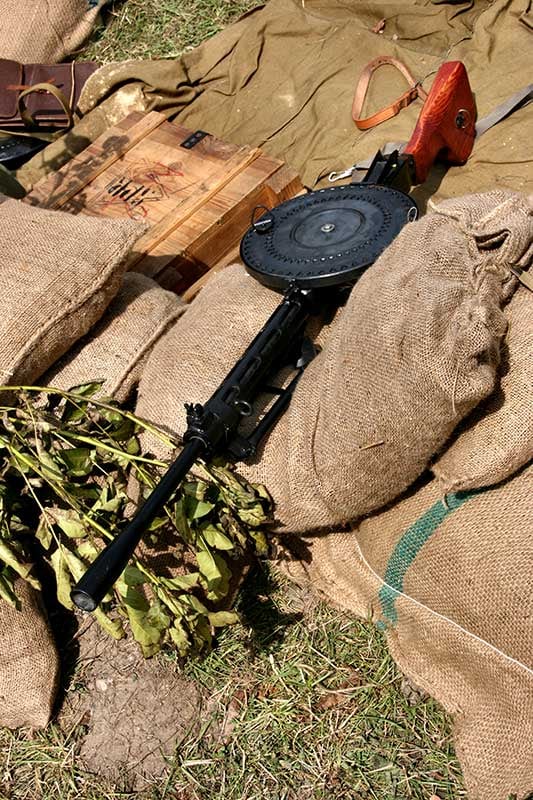Israel’s weapon industry is committed to excellence for the survival of a nation surrounded by enemies.
Finland’s more modest military output is aimed at defense against only one potential enemy, but when that adversary is Russia…well, after three savage wars, that’s enemy enough.
Most of Finland’s defense has involved making the most of what it obtains from foreign suppliers, but it has produced some indigenous designs of its own.
Read More: This is the real story behind the world’s first ‘assault rifle’
Read More: This machine gun was the Soviet version of the American M249
Among the most outstanding was the Suomi KP/31 Konopistooli, or “submachine gun.”
Finland’s declaration of independence from Russia in December 1917 was followed by a civil war between Whites who favored independence — aided by German volunteers — and Reds who wanted affiliation with the Bolshevik government, aided by the Soviet Union.
In the course of the fighting the Finns acquired so many bolt action Mosin-Nagant M1891 rifles to make it their infantry mainstay throughout World War II. They also acquired some German-supplied Bergmann M/20 SMGs, which were purchased as a supplement to its armed forces from 1922 on.
By then, however, Finnish weapons designer Aimo Lahti believed he could develop a less expensive, more effective SMG than the Bergmann and set about the task. He produced a series of such weapons that culminated in the KP/31, a blowback, select-fire SMG with a differential locking system.
In October 1931 the Finnish army placed the first order for 100 of the new weapons in 9/19mm caliber. Using machined components and wooden furniture, the KP/31 was not the easiest weapon to mass-produce and it would not be until the autumn of 1942 that there were enough to issue the two-per-squad loadout the Finnish army would have preferred.

By the end of 1943 enough were available to allow three per squad. By the time of the last climactic confrontation between the Soviet and Finnish forces in early June 1944, the latter had received more than 52,600 Suomis.
Later KP/31 variants, produced in response to criticism by soldiers of muzzle climb when fired fully automatic, feature a muzzle brake that increased the overall length and decreased muzzle velocity.
During the Continuation War of 1941-44, 500 Korsu-Suomis were made, with slimmer, longer carrel shrouds and a wooden pistol grip in place of the standard stock to make it easier to operate from within a bunker.
Reportedly 40 KP/31s of similarly compact design were built for use inside tanks or at close quarters outside of them. In the spring of 1944 a modification of the Suomi for combat engineers could operate as a flamethrower, but it is doubtful that more than 40 were produced.
The Suomi’s excellent accuracy up to 500 meters led to its wide initial use as a light machine gun (LMG) in support of the infantry, alongside the Lahti-Saloranta m/26 LMG. Neither gun was available in adequate numbers, in addition to which the m/26 proved heavy, awkward to use and had too many parts, making it hard to clean and maintain in the field.
After the Soviet Union initiated the Winter War on Nov. 30, 1939, however, the Finns captured such stocks of Degtyaryov DP-28 LMGs that were compatible with their own 7.62x54R cartridges that they were able to distribute those in their squads to more than supplement the m/26s and free up the Suomis for the more mobile SMG role.

As an SMG, the Suomi KP/31 held some advantages over its foreign counterparts. It could change barrels, allowing more sustained use in a firefight. Moreover, it used two different barrel types, one of which was accurate enough for a strong, steady, skilled submachine gunner to use it in the sniper role.
Its selector switch allowed it to fire single semiautomatic shots or automatic bursts, which the Finns usually limited to three to five shots to ensure accuracy. Strength was a necessity to counter the gun’s principal shortcoming — it was heavy, as were the five 70-round drums or seven 50-round box magazines that the Suomi gunner was expected to carry.
Besides its use by infantry squads for close-in fighting, the Suomi gained its most iconic notoriety in the hands of ski troops during the Winter War. Negotiating frozen terrain that they knew intimately, these special units ambushed Soviet road columns, breaking them up into isolated “mottis” (wood faggots for chopping) and then annihilating them one by one in a hail of machine gun fire.
It must be noted that the Soviet troops had an SMG of their own in the Pistolet-Pulamot Degtyaryova PPD-40, but they were neither as numerous nor as effectively used during the Winter War. The heavy casualties the KP/31s inflicted, compounded by the effect they had on morale, spurred the Soviets to develop better SMGs, starting with the PPSh-41.
Other foreign powers, noting the Suomi’s effectiveness as an offensive weapon, likewise sought to develop their own. Some were purchased by Germany, more than 5,000 were sold to Bulgaria and others were exported to Sweden, Denmark and Switzerland.
Sweden produced them under license as the kpist m/37-39, and sold them to Norway, Denmark, Indonesia and Egypt. Denmark license-built 1,000 before being invaded by the Germans in April 1940. Hispano-Suiza in Switzerland license-produced about 22,500, some of which were used by the Pontifical Swiss Guards at the Vatican until their replacement by Heckler und Koh MP5s in the 1970s.
The product of a thinly populated country in dire straits, the Suomi KP/31 cast a disproportionate shadow as one of the most successful and influential weapons of World War II.




